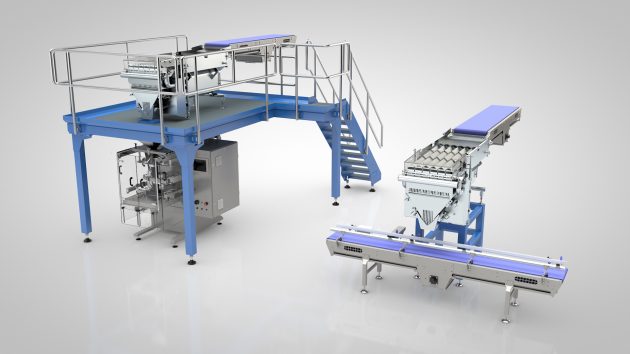
Count of three
By Cremer
Automation Cremer Optical counting machines Precision optical counting machines allow manufacturers to pack exact portions, thereby avoiding food waste.
Precision optical counting machines allow manufacturers to pack exact portions, thereby avoiding food waste. To avoid costly and reputation-damaging errors, food products must be apportioned precisely and packaged correctly. A common practice is to pack by weight. Unfortunately, some companies utilizing this long-embraced technique may also be weighing down their profit margins and brand reputations.
Precision optical counting guarantees 100 per cent accuracy—an exacting portion control leads to satisfied consumers and an upward trending ROI. Let’s explore a trifecta of ways counting improve profit margins, point-of-purchase marketing and production operations.
The value of an exact count
For food companies that sell large-container quantities, fast and accurate sorting, quantity apportionment and packing methods are essential for efficiency and quality control. From an end-of-line standpoint, among the most important decisions is whether to pack by weight or product count.
While some production lines utilize weighers to pack pieces by individual weight, problems can arise when using this technique. Typically, inaccurate quantities can result from products not being exactly the same weight. For example, frozen chicken nuggets. With these and similar items (fish sticks, etc.), there are generally small weight variances from piece to piece. Packing according to a total weight with products that have weight variations frequently leads to over or undercounts. While the effect is minimal in small quantities, such individually minor discrepancies become major when multiplied by thousands or even millions.
The resulting sizeable miscalculation can cause profitability issues. Undercounting shortchanges customers and causes dissatisfaction, decreasing sales by diminishing brand loyalty. Overcounting simply gives product away for nothing. The former impacts sales, the latter sell-ability, since you can’t sell something you’re handing out as a freebie. For products with slightly varying weights, packaging apportionment on a per-piece basis is the most efficient, cost-effective method. Optical counting guarantees the contents count is 100 per cent accurate for both wholesale and retail packages, preventing product loss and avoiding wastage via over- or under-filling.
Eliminating product giveaway is the most cost-saving notch on a counting machine’s belt. It’s not uncommon for packs of 20 products—frozen meatballs, for example—to have an extra in nearly every package. This is because food companies err on the side of too much versus too little, to avoid customer blowback from packages that have, say, 19 meatballs instead of 21. In food, more is less—less complaints, anyway.
However, more is also more: as more money is lost to overcounts. Multiply a five per cent attrition rate, and revenue lost to overage adds up fast. So, while replacing a traditional weighing system with precision counting equipment might seem like an onerous expense, money saved by eliminating product waste results in a quickly recouped infrastructure investment. Simply put, counters pay for themselves quickly, then keep making money for every extra product they don’t give away gratis.
As for undercounts, the advantage counting brings is obvious: no more complaints from customers who purchased a 20-count package with 19 items. Considering each official complaint represents exponentially more disappointed customers—most don’t bother to complain, they simply stop buying the product—the salvaged brand reputation and customer loyalty translates directly to bolstered profitability.
An informed consumer is a likelier customer
Counting also helps customers envision exactly what is in the package before making a purchase.
Let’s say someone is planning a party, and buying everyone’s favourite festive food: chicken wings. They know approximately how many people will attend the event, and about how many wings the average guest will eat.
Our party planner gets to the chicken wing freezer and sees three brands. Two bags are labeled “10 lb,” and the other “50 pieces.”
Now, unless the party planner knows how much the average chicken wing weighs, this shopping experience (and many others like it) plays out in numbers, not weight. The combined weight of the package’s contents is far less useful than knowing exactly how many products the package contains. This is especially relevant when a package is on the larger side—the bigger the package, the more nebulous total weight becomes.
Listing product count also gives customers information on how frequently to purchase that product, providing easier-to-track insight as to when they may be “running low.” No one ever says, “I only have three ounces of breakfast sausages left.”
Floor space
Counting systems also offer direct benefits for production facilities. Counting allows for elevated control over inventory, and provides ample production data to compare between different stages of the line. For example, a company would be able to ensure the number of pieces filled matches the number of pallets in the truck. This allows the supply chain process to be as precise as possible from the point of origin to the warehouse.
Counting machines have additional features that make them an attractive option for company’s prioritizing efficiency and conserving floor space. They are:
Smaller footprint, same output: More compact than weighing equipment, counters save floor space especially for longer production lines.
Reduced system height: Counting machines are shorter, reducing overall system heights, which is ideal for low-ceiling spaces where there is often no room to position a weigher directly over a packing machine.
Lower drop heights: With counters being shorter than weighers, they offer the benefit of lower drop heights. The farther up products are dropped, the more room there is for error, less accurate counts and possible damage from increased-velocity impact.
Less mechanics to clean/maintain: Counters have lower maintenance with less parts to clean and maintain. They have clean lanes and product separation, meaning less possibilities for product to become wedged in tight spaces. Here, adverse hygiene issues can come into play.
This article was originally published in the July/August 2021 issue of Food in Canada.
Print this page